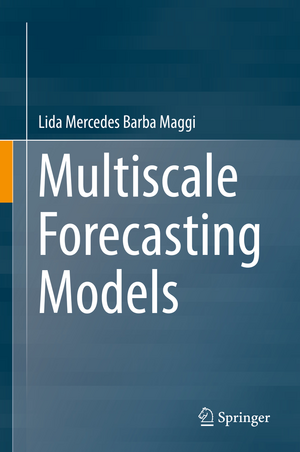Multiscale Forecasting Models
Autor Lida Mercedes Barba Maggien Limba Engleză Hardback – 31 aug 2018
Linear Auto-regressive models (AR, ARMA and ARIMA) and Auto-regressive Neural Networks (ANNs) have been found insufficient because of the highly complicated nature of some time series. Hybrid models are a recent solution to deal with non-stationary processes which combine pre-processing techniques with conventional forecasters, some pre-processing techniques broadly implemented are Singular Spectrum Analysis (SSA) and Stationary Wavelet Transform (SWT). Although the flexibility of SSA and SWT allows their usage in a wide range of forecast problems, there is a lack of standard methods to select their parameters.
The proposed decomposition HSVD and Multilevel SVD are described in detail through time series coming from the transport and fishery sectors. Further, for comparison purposes, it is evaluated the forecast accuracy reached by SSA and SWT, both jointly with AR-based models and ANNs.
| Toate formatele și edițiile | Preț | Express |
|---|---|---|
| Paperback (1) | 638.21 lei 6-8 săpt. | |
| Springer International Publishing – 3 ian 2019 | 638.21 lei 6-8 săpt. | |
| Hardback (1) | 644.48 lei 6-8 săpt. | |
| Springer International Publishing – 31 aug 2018 | 644.48 lei 6-8 săpt. |
Preț: 644.48 lei
Preț vechi: 805.60 lei
-20% Nou
Puncte Express: 967
Preț estimativ în valută:
123.34€ • 127.79$ • 102.93£
123.34€ • 127.79$ • 102.93£
Carte tipărită la comandă
Livrare economică 22 martie-05 aprilie
Preluare comenzi: 021 569.72.76
Specificații
ISBN-13: 9783319949918
ISBN-10: 3319949918
Pagini: 185
Ilustrații: XXIV, 124 p. 91 illus., 89 illus. in color.
Dimensiuni: 155 x 235 mm
Greutate: 0.39 kg
Ediția:1st ed. 2018
Editura: Springer International Publishing
Colecția Springer
Locul publicării:Cham, Switzerland
ISBN-10: 3319949918
Pagini: 185
Ilustrații: XXIV, 124 p. 91 illus., 89 illus. in color.
Dimensiuni: 155 x 235 mm
Greutate: 0.39 kg
Ediția:1st ed. 2018
Editura: Springer International Publishing
Colecția Springer
Locul publicării:Cham, Switzerland
Cuprins
Dedication.- Foreword.- Preface.- Acknowledgement.- List of Tables.- List of Figures.- Acronyms.- 1. Times Series Analysis.- 2. Forecasting based on Hankel Singular Value Decomposition.- 3.Multi-step ahead forecasting.- 4. Multilevel Singular Value Decomposition.
Notă biografică
Lida Mercedes Barba Maggi earned a PhD degree in Informatics Engineering from the Pontificia Universidad Católica de Valparaíso, Chile, in 2017. She is currently affiliated with the Universidad Nacional de Chimborazo in Ecuador. Her research interests include Analysis of time series, Forecast and estimate based on mathematical and statistical models, Forecast and estimate based on artificial intelligence, and Optimization Algorithms.
Textul de pe ultima copertă
This book presents two new decomposition methods to decompose a time series in intrinsic components of low and high frequencies. The methods are based on Singular Value Decomposition (SVD) of a Hankel matrix (HSVD). The proposed decomposition is used to improve the accuracy of linear and nonlinear auto-regressive models.
Linear Auto-regressive models (AR, ARMA and ARIMA) and Auto-regressive Neural Networks (ANNs) have been found insufficient because of the highly complicated nature of some time series. Hybrid models are a recent solution to deal with non-stationary processes which combine pre-processing techniques with conventional forecasters, some pre-processing techniques broadly implemented are Singular Spectrum Analysis (SSA) and Stationary Wavelet Transform (SWT). Although the flexibility of SSA and SWT allows their usage in a wide range of forecast problems, there is a lack of standard methods to select their parameters.
The proposed decomposition HSVD and Multilevel SVD are described in detail through time series coming from the transport and fishery sectors. Further, for comparison purposes, it is evaluated the forecast accuracy reached by SSA and SWT, both jointly with AR-based models and ANNs.
Linear Auto-regressive models (AR, ARMA and ARIMA) and Auto-regressive Neural Networks (ANNs) have been found insufficient because of the highly complicated nature of some time series. Hybrid models are a recent solution to deal with non-stationary processes which combine pre-processing techniques with conventional forecasters, some pre-processing techniques broadly implemented are Singular Spectrum Analysis (SSA) and Stationary Wavelet Transform (SWT). Although the flexibility of SSA and SWT allows their usage in a wide range of forecast problems, there is a lack of standard methods to select their parameters.
The proposed decomposition HSVD and Multilevel SVD are described in detail through time series coming from the transport and fishery sectors. Further, for comparison purposes, it is evaluated the forecast accuracy reached by SSA and SWT, both jointly with AR-based models and ANNs.
Caracteristici
The book is unique because it contains two new and competitive methods for time series decomposition to improve the accuracy of auto-regressive models The methods are presented in detail through relevant applications Additionally, the methods are compared with other techniques which are conventionally used in forecasting
